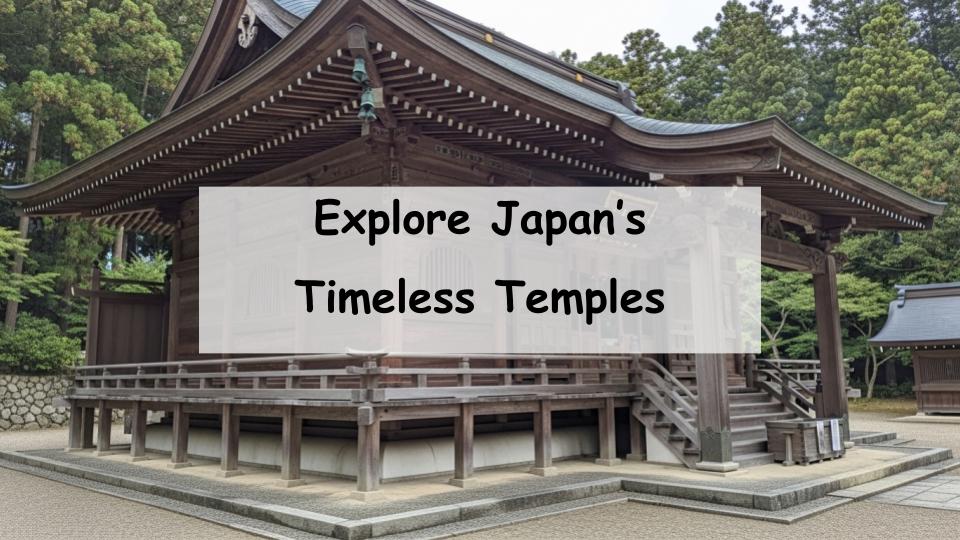With countless temples across Japan, how do you know which ones are truly worth visiting?
The answer lies in the unique value each temple holds—be it historical significance, stunning scenery, or a serene atmosphere that calms the soul. In this article, we introduce 5 carefully selected Japanese temples that every traveler should visit at least once.
From iconic sites in Kyoto and Nara to lesser-known hidden gems, each temple offers a different experience. We’ll highlight the charm, must-see points, and access information to help you plan a memorable temple journey.
- Why Visit Japanese Temples?
- 5 Must-Visit Temples in Japan
- 1. Kiyomizu-dera (Kyoto) – A Temple with a View
- 2. Todai-ji (Nara) – Home of the Great Buddha
- 3. Daigan-ji at Itsukushima Shrine (Hiroshima) – A Blend of Shinto and Buddhism
- 4. Hase-dera (Kamakura) – Temple of Hydrangeas and Kannon
- 5. Kongobu-ji (Koyasan, Wakayama) – The Spiritual Heart of Shingon Buddhism
- Tips for Enjoying Temple Visits
- Regional Highlights for Temple Travelers
- Conclusion|Find Peace and Inspiration in Japan’s Temples
- A Message from the Guide
Why Visit Japanese Temples?
Deeply Rooted in Japanese Culture and Spirituality
Temples in Japan are more than just religious sites—they’re living representations of the country’s cultural and spiritual heritage. Over centuries, temples have served as places of worship, cultural hubs, and sanctuaries for self-reflection. Their architecture, gardens, and spiritual energy tell the story of Japanese values and aesthetics.
A Journey for the Mind and Spirit
Stepping into a temple often feels like entering a different world. The peaceful silence, the scent of incense, and the sound of nature create a meditative space. A temple visit is not only a cultural experience but also an opportunity to slow down and reconnect with your inner self.
Stunning Scenery Throughout the Seasons
Japanese temples transform with the seasons—cherry blossoms in spring, lush greenery in summer, fiery red maple leaves in autumn, and snow-covered rooftops in winter. Visiting at different times of year offers a new perspective and renewed appreciation each time.
5 Must-Visit Temples in Japan
1. Kiyomizu-dera (Kyoto) – A Temple with a View
Kiyomizu-dera is one of Kyoto’s most iconic temples and a UNESCO World Heritage Site. The wooden stage that juts out from the main hall offers spectacular views of the city and the changing seasons. Founded in 778, its long history and impressive scenery make it a must-see destination.
2. Todai-ji (Nara) – Home of the Great Buddha
Todai-ji houses Japan’s largest bronze Buddha statue inside the world’s largest wooden building, the Great Buddha Hall. The temple, founded in the 8th century, represents the grandeur of ancient Japanese Buddhism. The scale and serenity of the site are unforgettable.
3. Daigan-ji at Itsukushima Shrine (Hiroshima) – A Blend of Shinto and Buddhism
While Itsukushima Shrine floats on the sea, nearby Daigan-ji Temple plays a vital role in the island’s spiritual life. It offers a rare look into Japan’s historical fusion of Shinto and Buddhism. The mystical coastal views and quiet surroundings create a truly unique experience.
4. Hase-dera (Kamakura) – Temple of Hydrangeas and Kannon
Located in Kamakura, Hase-dera is famous for its beautiful hydrangeas in early summer and its enormous wooden statue of Kannon, the goddess of mercy. The temple also offers panoramic ocean views and a peaceful garden, making it a favorite among nature-loving travelers.
5. Kongobu-ji (Koyasan, Wakayama) – The Spiritual Heart of Shingon Buddhism
Kongobu-ji is the head temple of Shingon Buddhism, nestled in the sacred mountains of Koyasan. The entire town exudes a spiritual atmosphere, and visitors can stay overnight in temple lodgings (shukubo), participate in morning prayers, and enjoy vegetarian temple cuisine (shojin ryori).
Tips for Enjoying Temple Visits
Learn the Etiquette Before You Go
When visiting temples, it’s important to respect local customs. Bow at the gate, purify your hands and mouth, and remain quiet within the grounds. Photography is often restricted in sacred areas, so be sure to check signs and follow the rules.
Time Your Visit with Seasonal Events
Temples host various festivals and ceremonies throughout the year, such as Setsubun, Hanamatsuri, and New Year’s celebrations. Visiting during these times offers a unique cultural insight and sometimes access to rarely seen parts of the temple.
Try Temple Experiences: Sutra Copying and Zazen Meditation
Many temples offer hands-on experiences like shakyo (sutra copying) and zazen (seated meditation). These activities help you engage with the temple’s spiritual side and provide a rare moment of mindfulness in your trip.
Regional Highlights for Temple Travelers
Great Temples in the Kanto Region
Kanto, which includes Tokyo and surrounding areas, has many famous temples like Naritasan Shinshoji, Kawasaki Daishi, and Yakuoin on Mt. Takao. These spots are perfect for short trips from the city and are rich in tradition and natural beauty.
Historical Powerhouses in the Kansai Region
Kansai is home to Japan’s most historically significant temples—Kinkaku-ji (Golden Pavilion), Horyu-ji, and Enryaku-ji, to name a few. These temples are deeply connected to Japanese history and offer rich stories and cultural depth.
Hidden Gems in Central, Kyushu, and Shikoku Japan
Regions like Nagano (Zenko-ji), Shikoku (88 Temple Pilgrimage), and Fukuoka (Kanzeon-ji) offer quieter, lesser-known temples for those seeking deeper experiences away from crowds. These areas often provide a more intimate and tranquil visit.
Conclusion|Find Peace and Inspiration in Japan’s Temples
Discover the Deeper Value of Travel
Japanese temples are more than places to see—they’re places to feel. Whether it’s spiritual awakening, cultural discovery, or simple inner peace, temples offer unique rewards that last beyond your trip.
Make Your Next Journey a Temple Journey
If you’re looking to add more meaning and serenity to your travels, consider visiting one of Japan’s incredible temples. It might just become the most memorable part of your journey.
A Message from the Guide

These days, I only travel to visit temples I want to see. Along the way, enjoying delicious food and fine drinks is pure bliss.























Comment